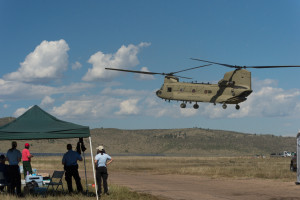CSU effort preserves oral history of 2013 flooding
by CSU MarComm Staff | October 21, 2015 10:01 AM
September 2015 marked the second anniversary of the floods that ravaged Colorado’s Front Range. In an interview about the devastation, Jamestown Mayor Tara Schoedinger recalled a dramatic moment following days of rain: “My husband … ran outside and said, ‘There goes the gulch.’ … He came back in less than a minute later, and he said, ‘Joey’s house collapsed, and he’s in it. Call 9-1-1.’”
As part of remembering the floods, the Water Resources Archive at the Colorado State University Libraries has made Schoedinger’s interview and 30 others available through its online repository. Each audio recording is accompanied by a full transcript.
 [1]
[1]The oral histories were created through collaboration of the Water Resources Archive and Colorado State University’s Public Lands History Center, with funding from the Colorado Water Conservation Board (CWCB). The three entities recognized the value of capturing first-hand accounts of the 2013 flood. With funding from the CWCB, principal investigator Ruth Alexander, project coordinator Naomi Gerakios Mucci and a team of researchers focused the project on people who managed emergency resources and directed recovery efforts.
From June to August 2014, the team interviewed climate scientists, water and stormwater managers, municipal and county administrators, dam engineers, emergency managers, search and recovery personnel, disaster relief personnel and park managers still dealing with the flood’s aftermath. Now the memories of people like Colorado State Climatologist Nolan Doesken and Glen Haven Volunteer Fire Chief Jason Gdovicak — and their assessments of emergency plans’ effectiveness — are available online to Colorado’s citizens.
Patrons can find specific interviews with keyword searches on the Archive’s website, http://lib.colostate.edu/water/[2] , or browse through the Northern Colorado Flood Oral History Collection finding aid, http://lib.colostate.edu/archives/findingaids/water/wncf.html[3]. The project’s final report is also linked through the finding aid. Photographs, reports and interview transcripts from the 1976 Big Thompson flood are also available through the Archive’s website.
The Water Resources Archive is Colorado’s only repository dedicated specifically to preserving the history of water in the state and the American West. Most of the documents in the Archive are unique and unavailable elsewhere. Holdings cover more than a century of water history and provide access to the studies, debates and legislative deals that have shaped Colorado’s water legacy.
- [Image]: http://source.colostate.edu/wp-content/uploads/2015/10/ChopperFlood2013.jpg
- http://lib.colostate.edu/water/: http://lib.colostate.edu/water/
- http://lib.colostate.edu/archives/findingaids/water/wncf.html: http://lib.colostate.edu/archives/findingaids/water/wncf.html
Source URL: https://source.colostate.edu/csu-effort-preserves-oral-history-of-2013-flooding/
Copyright ©2024 SOURCE unless otherwise noted.